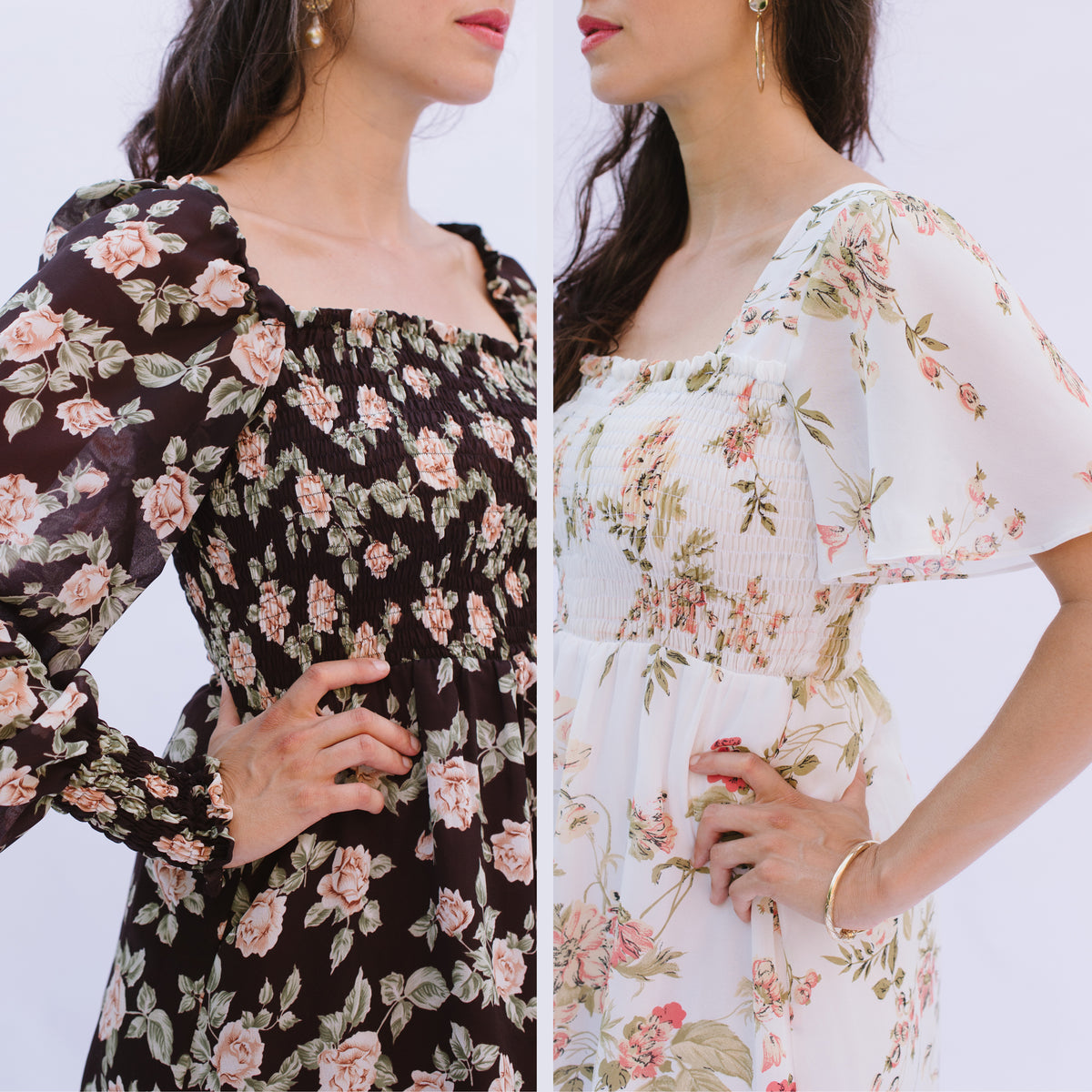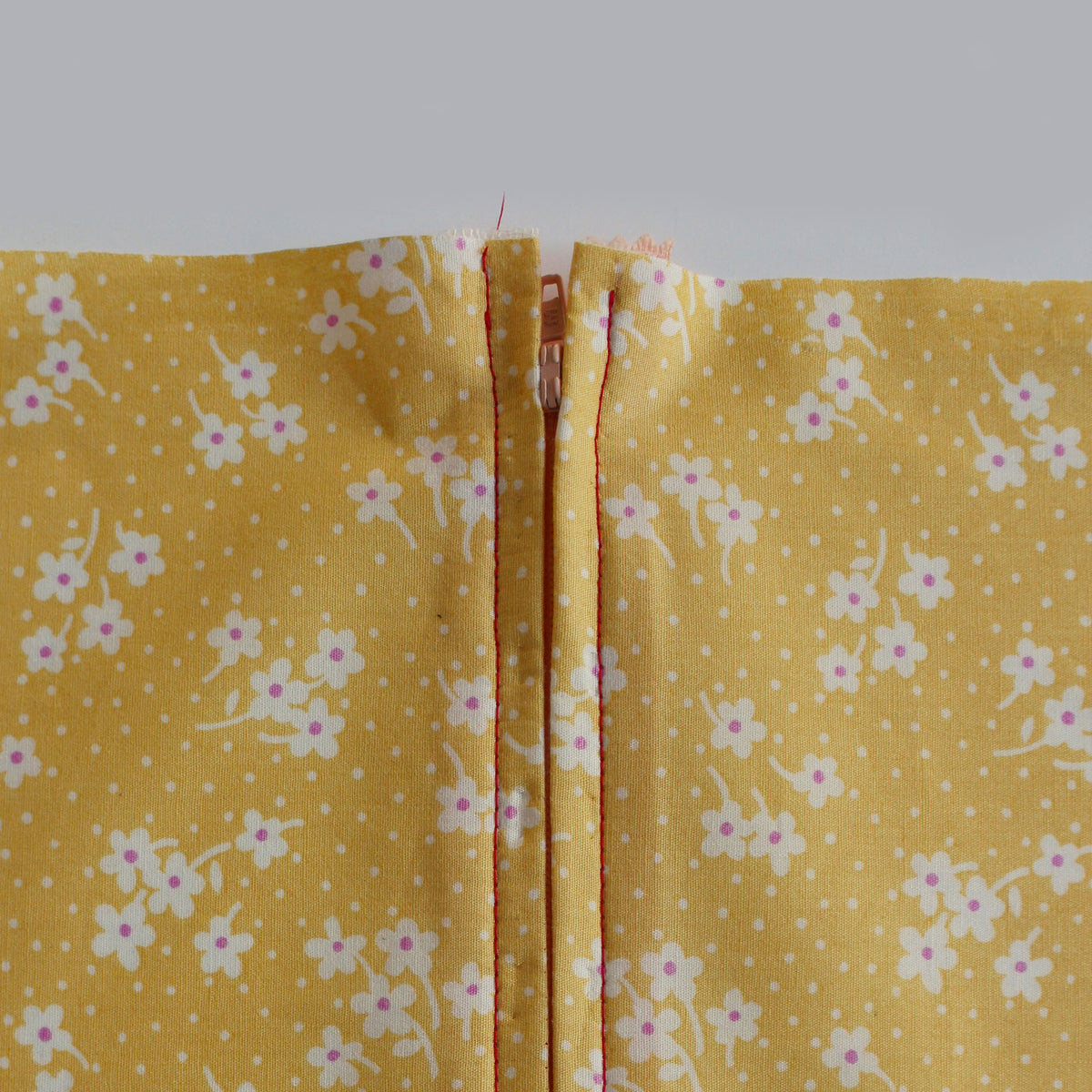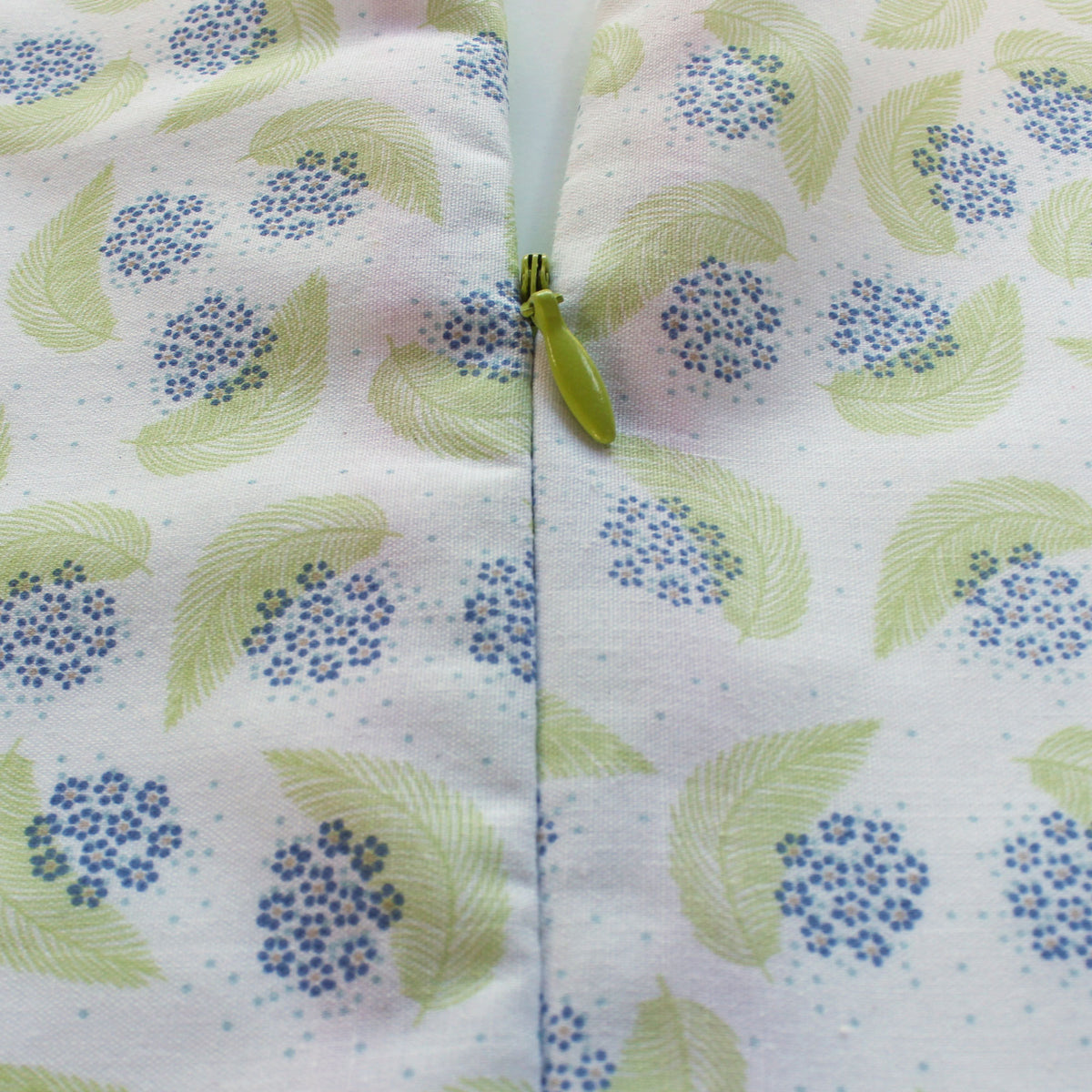Sofia Fit Adjustments

Shirring has a high percentage of stretch, which makes Sofia a very easy style to fit; that being said, there are still some adjustments that you may want to make to your pattern. In this post, we'll go over how to select your size, a few notes on making a muslin, adjusting the length of pattern pieces, adjusting for a full bust, and adjust the shoulder strap and Bell Sleeve.
Selecting A Size:
Bodice - Bust:
I would suggest picking your size based on your full bust measurement. There is a high percentage of stretch in the bodice, and a significant amount of wearing ease in the skirt, making fit very flexible for this style.
Bodice - Waist:
If your waist measurement is a one or two sizes up or down from your bust size, you can get away with making a straight size based on the selected bust size.
If your waist size is three or more sizes away from your selected bust size, I'd suggest grading between sizes at the waist and only grading one or two sizes from the bust size. By grading only one or two sizes away, the modification will provide some added circumference at the waist, without distorting the side seam shape significantly.
Skirt - Waist:
Select the size chosen for the waist area of the bodice.
Skirt - Hip:
The full A-line skirt is gathered at the waist, making the skirt free at the hip.
If your hip size is one or two sizes up or down from your selected bust/waist size, you can get away with using making a straight size based on the chosen bust size or waist size (if blended between sizes at the waist).
If your hip size is three or more sizes larger from your selected bust/waist size, I'd suggest grading sizes at the hip. Only grade one or two sizes from the waist size as this will provide so added circumference at the hip without distorting the shape of the skirt.
Making a muslin
A muslin is always a great step to take to help perfect your fit. You can also take the opportunity to practice the shirring technique, giving you a no-pressure project as you learn to get a handle on it. Before diving into the muslin, however, we'll go over the various pattern adjustments you can make.
I recommend working with a fabric that is close in weight and drape to your final fabric; this plays a significant role in how the shirring gathers up, affecting the fit's result.
Since the bodice is the critical fit point of the garment, I recommend making a crop top with your desired sleeve to test fit. If you need to pointers on how to sew shirring, I've created a tutorial that covers everything you need to know.
Some things to look out for with the fit on the sleeves:
- Determine if the sleeve length works for you, and make any desired changes.
- Test the shirring on your sleeve to see if it's comfortable for you. You may need to increase or decrease the tension on your shirring (see the shirring guide in the pattern).
- For the Bell Sleeve style, test the length of the strap length before cutting and sewing the Bell Sleeve. If strap length adjustments are required, Bell Sleeve adjustments will also be needed. These adjustments must be made at the pattern stage. Stay tuned below for tips on how to make these adjustments.
Length Adjustment:
Sofia is designed for a height of 5'7". If you are taller or shorter, and you would like to maintain the garment proportions, you can adjust your garment length.
When making length adjustments, I always like to consider the upper and lower half of the body, and then consider the length adjustment needed for the respective pieces.
Bodice Length Adjustment
The Bodice length will need to be adjusted if you have a longer or shorter torso. To determine if a length adjustment is necessary, measure your back length and compare to the patterns' back length measurement (15.5")
To measure your back length, begin measuring at the bone protrusion at the base of the neck, continue along your spin, straight down to the natural waistline.
- If your back length is 14", reduce the bodice length by 1.5" (15.5 - 14 = 1.5)
- If your back length is 16.5, increase the bodice length by 1" (16.5 - 15.5 - 1)
Lengthening the Bodice
- Cut along the lengthen/shorten line
- Insert a piece of paper in between the two sections. Tape the upper section to the paper.
- With a ruler, draw a line along the cut pattern edge. The distance between the pattern and this line should equal your adjustment amount.
- Tape the lower portion of the pattern to the paper, aligning the cut edge to this line.
- Make sure that the center front edges of the two pattern sections are parallel.

Shortening the Bodice
- Draw a line above and parallel to the lengthen/shorten line. The distance from this line and the lengthen/shorten line should equal your adjustment amount.
- Fold the bodice pattern along the lengthen/shorten line. Align the folded edge to the drawn line and tape the edge in place.
- Make any necessary adjustment to the side seam edge, which may be affected by the adjustment. The edge must be smooth and take a similar shape to the original pattern line.

Skirt Length Adjustment:
The skirt length is designed to be 33", measuring from the waist to hem.
To figure out if a length adjustment is needed, I like to consider the length based on my preference for where I want the hem to hit. I suggest placing the measuring tape with the 0" at your side, along your natural waist. Let the tape hang down and take note of where 33" hits you. Consider if there is a preferred length for your height. Take note of the difference in length, and add or subtract this amount to/from the pattern.
Don't forget that if a length adjustment is made, it may change your fabric requirements, this is most important if you're lengthening the pieces, as you want to make sure you have enough fabric.
Lengthening the Skirt
- Cut along the lengthen/shorten line.
- Insert a piece of paper in between the two sections. Tape the upper pattern section to the paper.
- With a ruler, draw a line along the cut pattern edge. The distance between the pattern and this line should equal your adjustment amount.
- Tape the lower portion of the pattern section to the paper, aligning the cut edge to this line.
- Make sure that the center front edges of the two pattern sections are parallel.
- Realign the pattern along the side edge, drawing a straight line from the waist to the hem. If necessary, tape a small piece of paper along the side seam.

Shortening the Skirt:
- Draw a line below and parallel to the lengthen/shorten line. The distance from this line and the lengthen/shorten line should equal your adjustment amount.
- Fold the bodice pattern along the lengthen/shorten line. Align the folded edge to the drawn line and tape the edge in place.
- Realign the pattern along the side edge, drawing a straight line from the waist to the hem. If necessary, tape a small piece of paper along the side seam.

Bell Sleeve Adjustment
You want to make sure that the shoulder strap length fits before making your final version. I highly recommend making a muslin of this component, even if you choose not to make a muslin of the body.
Once you fit the strap, determine if length should be added or taken away. Refer to your pattern piece to locate the lengthen/shorten placement lines; you do not want to interfere with the portion of the strap where the sleeve gathers align.
Keep in mind that since there are two locations for lengthening, if your total adjustment amount is 3/4" (2 cm), then this will be divided between the two adjustment lines, making for a 3/8 (1 cm) adjustment at each line.
The method for lengthening shortening is the same as in the bodice instructions above.

If length adjustments are made to the strap, adjustments must then be made to the Bell sleeve. On the pattern piece, you will notice lengthen shorten lines place in two directions on the sleeve. The red lengthen/shorten lines are used if an adjustment to the shoulder strap is made; this will adjust the sleeve width accordingly.
The blue lengthen/shorten lines are used to adjust the length of the sleeve. This adjustment is based on your personal preference.

If you shortened the shoulder straps, decrease the width of the Bell sleeve.
- Use a ruler to draw a parallel line along the lengthen/shorten line. The distance should equal the adjustment amount made to the shoulder strap.
- Fold along the lengthen/shorten line.
- Match the folded line to the adjustment line and tape in place.
- Blend a new tidy curve along the sleeve cap edge. You may need to attach a small piece of paper to accommodate the new sleeve cap curve.

If you lengthened the shoulder straps, increase the width of the Bell sleeve.
- Cut the Belle sleeve along the lengthen/shorten lines.
- Insert a piece of paper in between the three sections. Tape the middle section to the paper.
- Use a ruler to draw a parallel line along the lengthen/shorten line. The distance should equal the adjustment amount made to the shoulder strap.
- Fold along the lengthen/shorten line.
- Tape the two side portions of the pattern to the paper, aligning the cut edge to this line.
- Blend a new tidy curve along the sleeve cap edge. You may need to attach a small piece of paper to accommodate the new curved sleeve cap line.

For making an adjustment to the length of the sleeve, follow the same instructions for adjusting length on the Bodice or Skirt.
 Adding length to the Bell sleeve.
Adding length to the Bell sleeve.

Reducing the length of the Bell Sleeve.
Adjustments for a Full Bust:
Sofia is a unique case for bust adjustments for a few reasons; this is a flat piece of fabric that received a high percentage of stretch once it's shirred. The stretch allows the fit to be flexible, conforming nicely to the curves of any size or shape. The pattern can accommodate many cup sizes, from A to D, without there being a need for an adjustment.
If you have a larger cup size, you may find the front of the bodice riding up, creating a situation where the waistline is not level. Now, since there are many straight/evenly spaced shirring lines sewn across the bodice piece, we want to maintain this feature. A traditional FBA would have us leave the side seam length and create length elsewhere along the bodice's front. Since the rectangular shape must be maintained here, we'll go about this differently.
We will be lengthening the front bodice piece, and maintaining the length of the back bodice piece. The side edges of the front bodice will be gathered up to match the back piece's length; this will create the length required for the front bodice to produce a level waistline while creating an equal side seam.
The best way to determine precisely how much to add to the front piece is to make a muslin and calculate how much length should be added based on your fit. Other than that, there are a few factors that complicate the ability to calculate the exact amount to add for each individual, but I think it's safe to say that if you add 3" to the front piece, it will be enough. For the instructions below, I'll use 3" as the adjustment amount.
Full Bust Adjustment for Sofia
- Trace the bodice piece so that you have two bodice pattern pieces. Label one "Front" and the other, "Back."
- Leave the Back piece as is.
- Working with the front piece, follow the directions for lengthening the bodice above. Add the amount of length needed for your adjustment (3").
Sewing the Adjusted Bodice:
You will need to add a few construction steps for this adjustment.
- Complete the shirring on the bodice pieces.
- Before the side seams of the front and back bodice are sewn, sew a gather stitch along the bodice's side edges.
- For each side, start the gather stitch at the underarm edge and sew halfway along the bodice's length.
- Pin the Front and Back Bodice pieces right sides together along the side seams. Draw in the gather threads, taking up the fullness along the side edge of the front bodice —pin in place.
- Baste the side edges of the bodice together.
- Test the fit of the bodice. If the front needs to be shortened, reduce any excess length along the waist edge.
- If adjustments were made, removed the basting stitch and re-sewn the side seams with a regular stitch.

Join me in the next post in the sewalong series where we go over the cut list for the Sofia pattern
YOU MAY ALSO LIKE:
Leave a comment
Comments will be approved before showing up.
Also in The Victory Patterns Blog

Pair the Sofia Bell Sleeve Strap with any sleeve option

How to sew a centered zipper
A centered zipper is one of the most usefull zippers to be able to sew. They are commonly used in skirts, dresses, and pants, as well as cushion covers and handbags. In this tutorial, we'll show you how to sew a centered zipper using directional sewing, which avoids the fabric from shifting in different directions once the zipper is sewn in.



